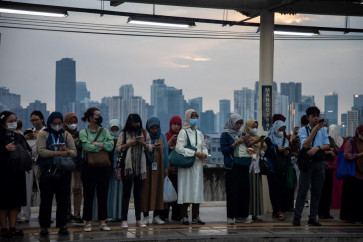Popular Reads
Top Results
Can't find what you're looking for?
View all search resultsPopular Reads
Top Results
Can't find what you're looking for?
View all search resultsLeonard Retel Helmrich The pioneer of single shot cinema
Dutch documentary filmmaker Leonard Retel Helmrich has received numerous accolades in his career that has spanned almost 30 years
Change text size
Gift Premium Articles
to Anyone
D
utch documentary filmmaker Leonard Retel Helmrich has received numerous accolades in his career that has spanned almost 30 years.
As a filmmaker, Helmrich has won at least 20 international documentary film awards, including the Best Feature Length Documentary award at the prestigious International Documentary Film Festival Amsterdam (IDFA) for his Position Among The Stars documentary in 2010.
Helmrich is also a pioneer in his own right. He invented a cinematic style that he calls the single-shot cinema technique, which was first introduced to audiences in Moving Objects, his documentary that won the Special Jury Prize for the Best Artist-Profile at the San Francisco International Golden Gate Film Festival in 1992.
'Single-shot cinema is a method of filming where you constantly are focused on the subject and you are telling a story constantly,' Helmrich told The Jakarta Post on the sidelines of the Erasmus Documentary Film Festival (ErasmusDocFest).
In single-shot cinema, he said the camera continuously orbited around a subject and captured all real life and real time moments to narrate the stories in a documentary. He invented the single-shot cinema technique after he saw how cameras were getting smaller as technology advanced.
'I noticed actually that when cameras became smaller, lighter and more light sensitive, most filmmakers did not change their visual language,' he said.
'They just stuck to how they are used to making films, like a lot of shots and cutting back and forth between people, while actually the only reason why we had to do the editing and use the script and the tripod and everything is because the cameras were too big and bulky and it was difficult to move around.
'But now, it's obsolete. Now, you don't need to have a tripod [...] Now you can move around so you should use it and you can use the moving camera to narrate the stories. If you are now able to move around, you will have more freedom in telling your stories in a very visual way.'
Helmrich later perfected the technique and used it in his highly acclaimed trilogy ' Eye of the Day (2001), Shape of the Moon (2004) and Position Among the Stars (2010).
The trilogy told the story of a family trying to survive hardships in the slums of Jakarta. Helmrich's single-shot cinema technique allowed the documentary on them to be told as visually exciting and entertaining as a fiction feature film. This, according to Helmrich, is the power of the technique. It narrates captured reality and delivers it in a profound visual language that captivates the audience.
'The reason why I make documentaries is because I think most documentaries are heavy and boring. I say you can do it differently. It does not have to be boring.'
His single shot cinema technique makes his documentaries stand out from others because it allows him to not use a lot of voice-overs in telling the story and to really be able to take the audience right into the life of the subjects being documented.
'A good documentary is one where you have the feeling that you know the people [in the documentary] personally,' he said.
In his latest project, he teaches new and aspiring documentary filmmakers in Indonesia how to use the single-shot cinema technique in their works.
The project is a workshop in which Helmrich, along with several documentary filmmakers from Jambi, produced a documentary titled Sang Pembakar (The Arsonist). This film takes a look at the burning of forest areas and their conversions into oil palm plantations near Jambi.
One of the workshop participants, Hari Suprayitno, said the opportunity to learn the single-shot cinema technique from Helmrich was once in a lifetime experience.
'Other documentaries rely on narrations through voice-overs and interviews but by using the single-shot camera technique, we can directly tell the story through the real life moments that we capture from different angles,' Hari said
Helmrich hoped his workshop would allow more high quality, exciting and entertaining documentaries to be produced in Indonesia, a country which he described as having a special place in his heart.
'There are so many subjects to be documented here,' said Helmrich, who has a Javanese mother and a father who was born in Semarang, Central Java.
' For details visit twitter.com/erasmusdocfest










